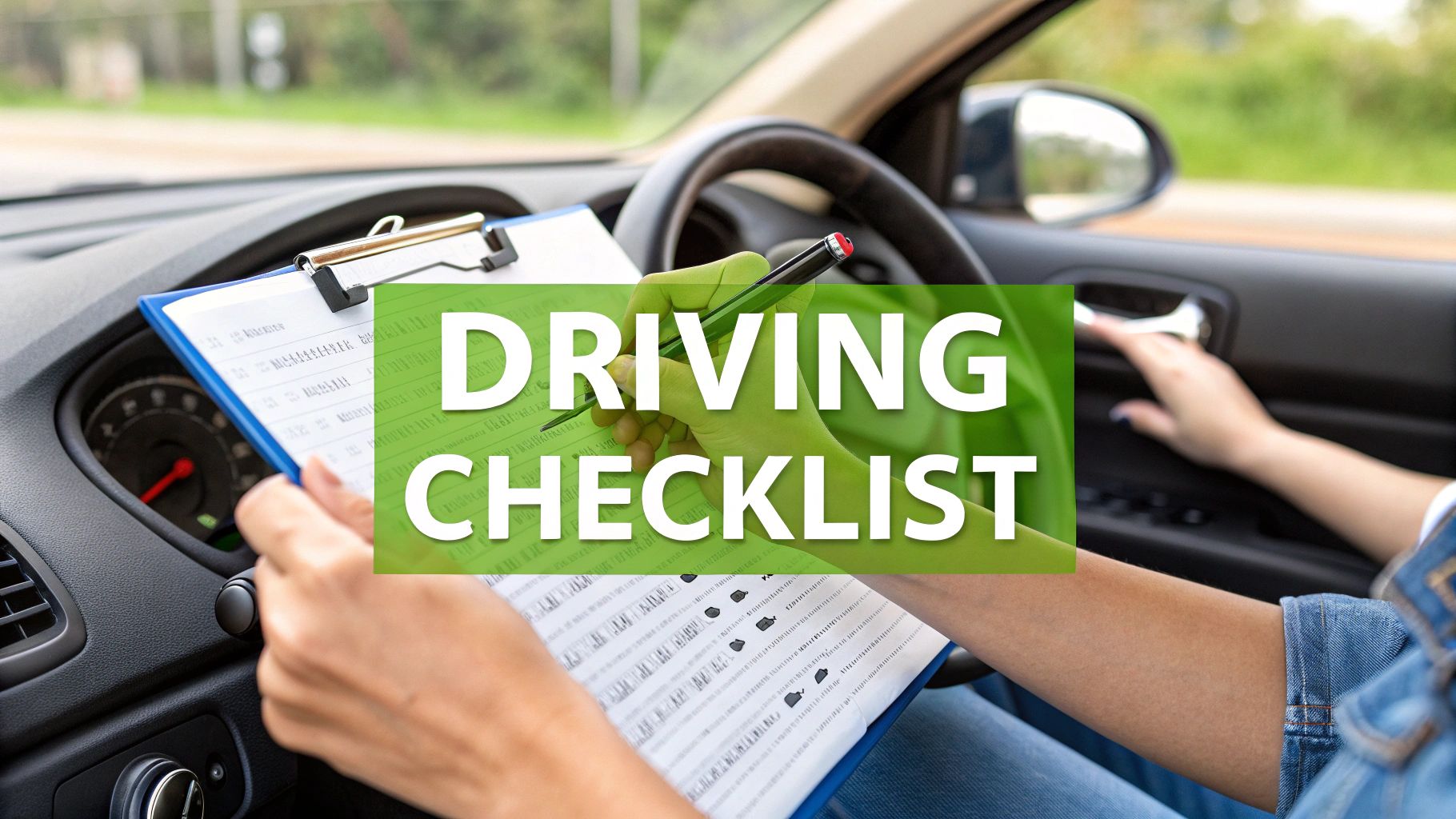Getting behind the wheel for a driving lesson is a milestone moment, a mix of excitement and nerves. But success isn't just about what happens on the road; it's about the preparation you do beforehand. A structured approach can transform that anxiety into confidence, ensuring every minute with your instructor counts.
This definitive driving lesson checklist is designed to do just that. We move beyond the obvious 'bring your provisional licence' advice to provide a comprehensive roundup of the core skills and knowledge that form the bedrock of safe, confident driving. By systematically reviewing these key areas, from pre-drive vehicle checks to understanding the nuances of high-speed driving, you'll arrive organised, focused, and ready to fast-track your journey to passing your practical test. Let’s get you ready for the road.
1. Pre-Drive Vehicle Inspection
Before you even turn the key, a thorough pre-drive vehicle inspection is a non-negotiable first step. This isn't just about ticking boxes; it's a fundamental safety routine that instils lifelong good habits. This check ensures your vehicle is safe to operate, preventing potential malfunctions that could cause a hazard during your lesson. Think of it as your first test of observation and responsibility as a driver.
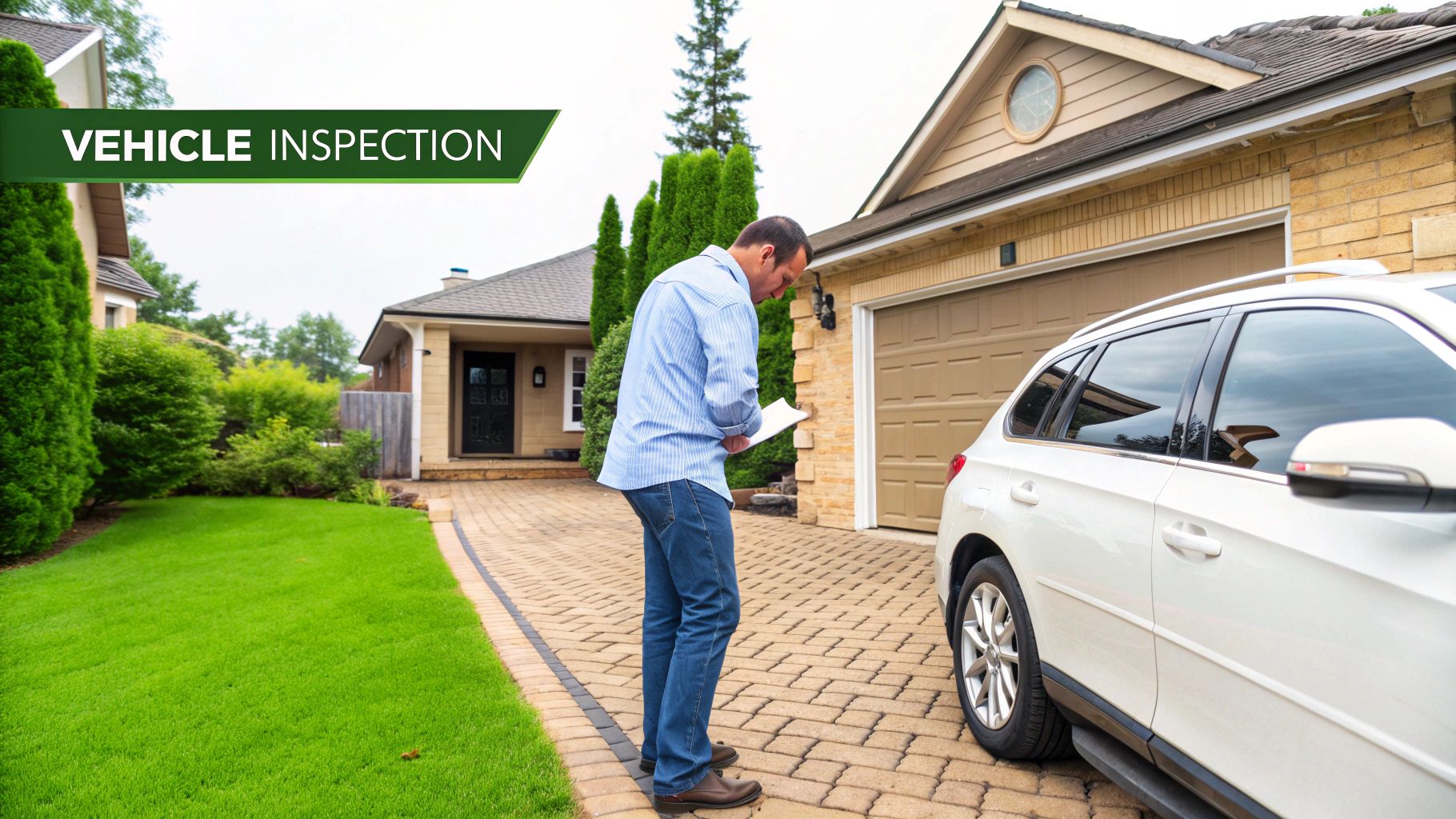
This practice is standard in professional driving sectors for a reason. Commercial driving schools often mandate a 15-point inspection, and lorry drivers complete a daily vehicle inspection report. Even the UK practical driving test incorporates "show me, tell me" questions, where you must demonstrate knowledge of basic car safety checks. Making this a core part of your driving lesson checklist prepares you for both the test and real-world driving.
How to Perform Your Check
To build a consistent habit, always start your inspection from the same point, such as the driver's door, and work your way around the vehicle.
- Tyres and Wheels: Check for visible damage, ensure they are properly inflated, and confirm the tread depth is above the legal minimum of 1.6mm.
- Lights and Indicators: Quickly test your headlights, brake lights, and indicators to ensure they are all working correctly.
- Mirrors and Glass: Adjust your wing and rear-view mirrors for maximum visibility and ensure all windows and the windscreen are clean and free from obstructions.
- Under the Bonnet: Regularly check your engine oil, coolant, and windscreen washer fluid levels. A simple acronym to remember is FLOWER: Fuel, Lights, Oil, Water, Electrics, Rubber (tyres).
2. Traffic Rules and Road Signs Comprehension
Mastering the rules of the road is the theoretical bedrock upon which all practical driving skills are built. Before you even sit in the driver's seat, a comprehensive understanding of traffic laws, road signs, and right-of-way conventions is critical. This knowledge isn't just for passing your theory test; it's the legal and safety framework that governs every decision you make behind the wheel. It's an indispensable part of any complete driving lesson checklist.
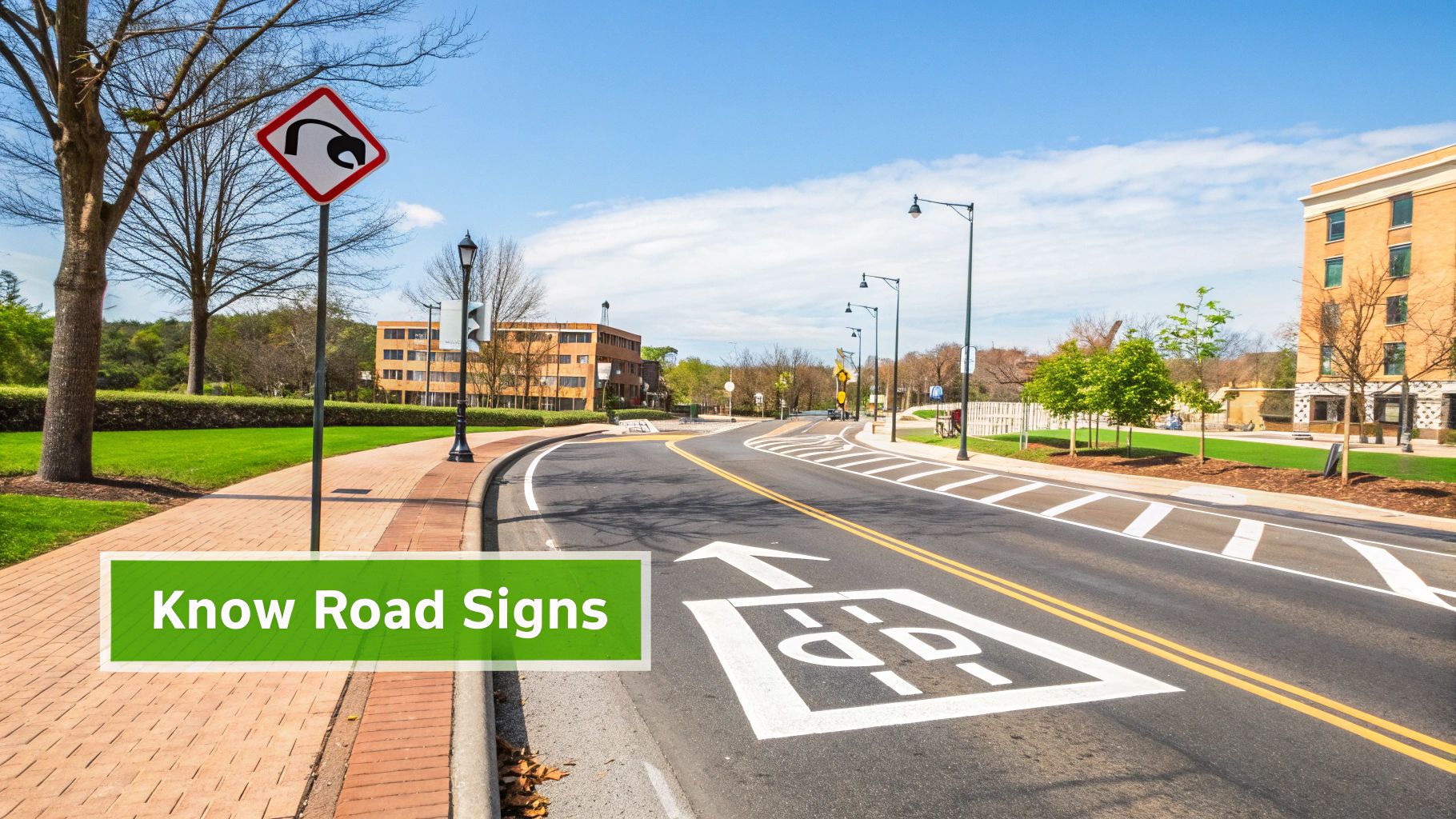
This focus on theoretical knowledge is a global standard. For example, Germany's rigorous system demands extensive classroom-based learning before practical lessons can even begin. In the UK, a deep understanding of the Highway Code is essential, as this knowledge is directly tested in both the theory and practical driving tests. By studying these rules first, you can focus your attention during the lesson on applying the knowledge, not learning it from scratch. For more details on this, you can explore this handy guide for the driving theory test.
How to Improve Your Comprehension
Integrate theoretical study into your daily routine to build a strong foundation for your practical lessons. This proactive approach will accelerate your on-road learning.
- Study the Highway Code: This is your primary resource. Don't just skim it; study the sections on road signs, markings, and general rules until they become second nature.
- Use Practice Apps: Utilise mobile apps that offer mock theory tests and road sign recognition quizzes. This is a great way to test your knowledge in a simulated environment.
- Observe as a Passenger: When you're a passenger in a car, actively identify road signs and predict the driver's actions based on the rules. This connects theory to real-world situations.
- Understand the 'Why': Focus on understanding the logic behind a rule, such as why a particular speed limit is in place, rather than just memorising the number itself.
3. Basic Vehicle Control and Operation
Mastery of your car's fundamental controls is the mechanical foundation of safe driving. This goes beyond simply knowing what the pedals and steering wheel do; it involves developing the muscle memory for smooth, precise, and coordinated operation. Gaining this control over steering, acceleration, braking, and (if applicable) gear shifting is a core objective of your early driving lessons. This skill separates a novice from a confident, capable driver.
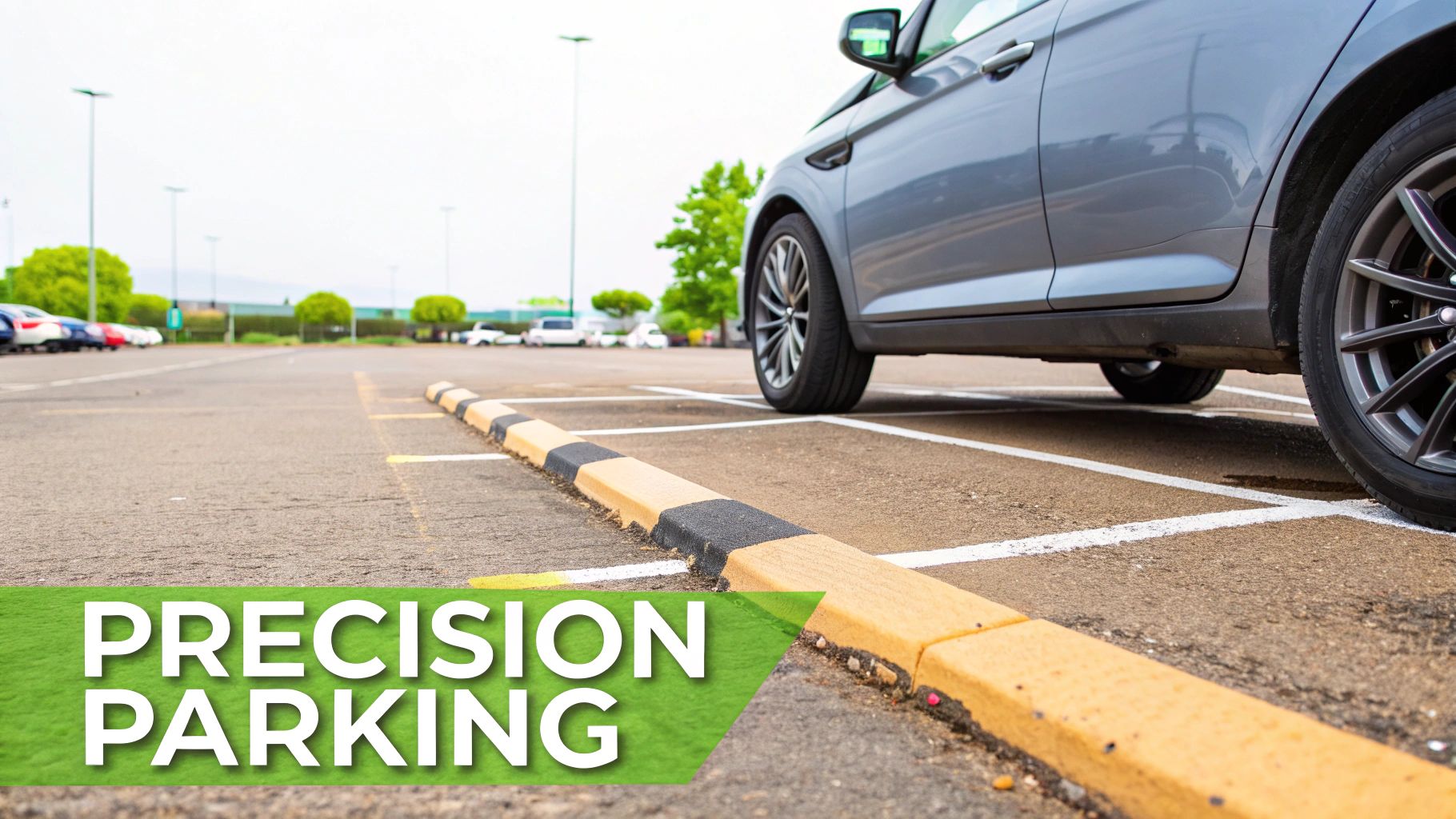
This focus on fine motor control is universal in driver education. Professional racing schools use advanced simulators to hone drivers' throttle and brake inputs to a millisecond, and graduated licensing programmes prioritise basic control in safe environments before allowing learners onto public roads. Your driving lesson checklist must include dedicated time to this practice, as it builds the subconscious skill needed to react safely in complex traffic situations without having to think about the mechanics.
How to Master Vehicle Controls
Your instructor will guide you, but you can focus on these key areas to accelerate your learning. The goal is to make your inputs smooth, not sudden or jerky.
- Steering and Hand Position: Keep your hands at the '9 and 3' positions on the wheel for maximum control. Practise smooth, controlled turns using the 'pull-push' steering method.
- Smooth Acceleration and Braking: Apply gentle, progressive pressure to both the accelerator and the brake pedal. Aim to glide to a stop rather than jolting the car.
- Clutch Control (Manual Cars): Find the 'biting point' of the clutch. Practise slowly lifting your foot to achieve a smooth start without stalling or revving the engine excessively.
- Practice Environment: Utilise quiet, empty car parks or industrial estates in your initial lessons to build confidence with the controls before tackling busy roads.
4. Parking and Maneuvering Skills
Mastering precise vehicle control in tight spaces is a cornerstone of confident driving. This involves more than just passing the test; it's about developing the spatial awareness needed for everyday situations, from busy supermarket car parks to narrow residential streets. These skills, including parallel parking, bay parking, and turning in the road, are a core part of your driving lesson checklist because they demonstrate a high level of clutch control, observation, and accuracy.
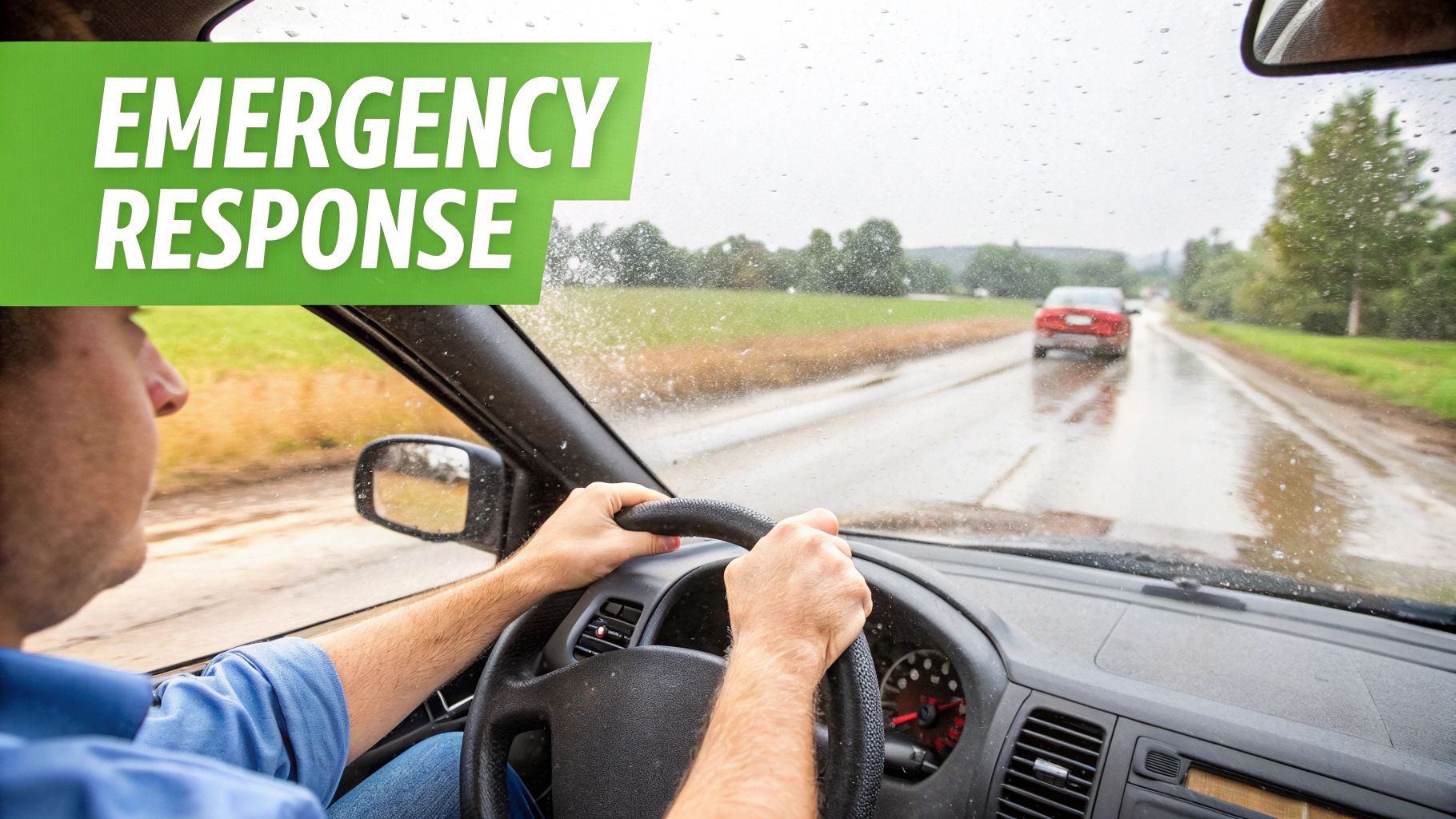
This focus is a global standard for a reason. European driving schools heavily emphasise precise manoeuvres, and even professional valet drivers rely on advanced positioning techniques, not just technology. The UK practical driving test will require you to perform at least one of these manoeuvres perfectly. Consistently practising them builds the muscle memory and judgement required for real-world driving scenarios, ensuring you are a safe and competent driver long after you've passed your test. You can get more details on the driving test manoeuvres on fastpassdrivingcourses.co.uk.
How to Practise Your Manoeuvres
Breaking down each manoeuvre into a sequence of steps is the key to consistency. Your instructor will provide reference points unique to your training vehicle.
- Use Reference Points: Identify specific points on your car (e.g., a sticker on a window, the edge of a door mirror) that align with external markers like kerbs or lines. This creates a repeatable formula for success.
- Master Your Mirrors: Learn to use your wing and rear-view mirrors effectively for judging distance and position. Relying on them over a reversing camera builds better spatial awareness.
- Slow and Steady: All manoeuvres should be performed at a slow, controlled walking pace. This gives you time to think, observe, and make small, precise steering adjustments.
- Practise with Markers: Before attempting to park between real cars, use cones or even cardboard boxes in an empty car park to simulate the space and build confidence without risk.
5. Defensive Driving Techniques
Mastering the physical controls of a car is only half the battle; the other half is adopting a proactive mindset. Defensive driving is this mindset in action. It’s about anticipating potential hazards, assuming other road users might make mistakes, and prioritising safety above all else. This approach moves you from being a reactive driver, who simply responds to events, to a proactive one who actively prevents them from happening. It’s a crucial element of any complete driving lesson checklist.
This safety-first philosophy is the foundation of training for professional drivers. For instance, the renowned Smith System, popularised by Harold Smith, uses "5 Keys to Space Cushion Driving" to dramatically improve safety records for commercial fleets. Similarly, emergency service drivers are trained to a high standard of defensive driving, enabling them to navigate traffic safely at speed. Integrating these principles early on will make you a safer, more confident driver for life.
How to Drive Defensively
Incorporate these techniques into every drive to build strong, safe habits from the start. Your instructor can help you practise these during your lessons.
- Maintain a Safe Following Distance: Use the three-second rule as a minimum in good weather. Pick a fixed point, like a sign, and as the car in front passes it, count "one-thousand-and-one, one-thousand-and-two, one-thousand-and-three". If you pass the point before finishing, you are too close. Increase this to six seconds or more in wet or icy conditions.
- Scan Ahead and Around: Constantly scan the road 12-15 seconds ahead, not just focusing on the car directly in front. Look for potential hazards like pedestrians, cyclists, or cars waiting to pull out.
- Create Escape Routes: Position your vehicle in your lane to give yourself space on either side. Avoid driving in other drivers’ blind spots and always have a plan B if you need to take evasive action.
- Assume the Worst: Expect other drivers to make errors. Assume a car waiting at a junction might pull out, or a vehicle might drift into your lane. This keeps you prepared and reduces the chance of being caught by surprise.
6. Emergency Situations and Hazard Response
While nobody wants to encounter an emergency, preparing for one is a critical part of a comprehensive driving education. This goes beyond standard hazard perception; it involves knowing how to react physically and mentally when your vehicle behaves unexpectedly. Understanding how to handle situations like a tyre blowout or a skid is a life-saving skill that instils confidence and control, turning potential panic into a measured response. This preparation is a cornerstone of advanced driving, making it an essential part of your driving lesson checklist.
This proactive approach is standard practice for professionals who face high-stakes situations. Emergency vehicle operators and professional racing drivers undergo extensive training to master responses to sudden vehicle failures. Similarly, winter driving courses in Nordic countries focus heavily on skid control. Integrating these principles into your learning ensures you are prepared not just for the driving test, but for the unpredictable nature of real-world driving.
How to Prepare for an Emergency
Discuss these scenarios with your instructor and ask to practise them in a safe, controlled environment.
- Practise Emergency Braking: In a clear, open space, practise braking firmly and quickly to understand how the car and its ABS (Anti-lock Braking System) respond.
- Learn Skid Control Theory: Understand the principle of "steering into the skid." If the rear of your car slides to the right, you steer gently to the right to regain control. Avoid braking heavily, which can make the skid worse.
- Know Your Vehicle's Systems: Familiarise yourself with where the hazard warning light button is and how to use it instantly. Also, know how to contact roadside assistance if needed.
- Stay Calm and Avoid Overcorrection: The most common mistake in an emergency is a sudden, jerky reaction. Practise staying calm and making smooth, deliberate steering and braking inputs to maintain as much control as possible. For more guidance, you can explore detailed resources to improve your hazard perception skills.
7. Weather and Environmental Driving Conditions
Adapting your driving to the prevailing weather is a critical skill that moves beyond basic vehicle control. The ability to handle your car safely in rain, fog, or icy conditions is a sign of a competent and responsible driver. Learning this during your lessons provides a safe, controlled environment to understand how environmental factors affect vehicle performance, stopping distances, and overall road safety. This is a key part of any comprehensive driving lesson checklist.
This focus on adaptability is a core principle in advanced driver training globally. For instance, Scandinavian winter driving programmes dedicate significant time to mastering vehicle control on snow and ice, while desert driving courses in the Middle East teach techniques for sand and extreme heat. Including this in your learning prepares you for the unpredictable nature of UK weather, ensuring you are not just a fair-weather driver but one equipped for year-round safety.
How to Adapt to Conditions
Your instructor will guide you, but developing the right mindset and habits is crucial. Always adjust your driving style before a hazard develops, not in reaction to it.
- Reduce Speed and Increase Following Distance: In adverse conditions like rain or fog, visibility is reduced and stopping distances can double. Slow down and leave at least a four-second gap between you and the vehicle in front.
- Use Gentle Inputs: Sudden movements can cause a loss of grip. Practise smooth and gentle steering, acceleration, and braking to maintain traction and control.
- Recognise Hazards: Learn to spot the tell-tale signs of black ice, such as a glossy, wet appearance on the road when other surfaces are dry. Understand the feeling of hydroplaning when your tyres lose contact with the road surface in heavy rain.
- Prepare Your Vehicle: Ensure you have seasonal essentials. In winter, this means having sufficient screenwash with antifreeze, good tyre tread, and fully functioning lights and wipers.
8. Highway and High-Speed Driving
Transitioning from local streets to motorways or dual carriageways is a major step in your driving education. This part of your driving lesson checklist focuses on mastering high-speed environments, where reaction times are shorter and the consequences of errors are more significant. Mastering this skill involves more than just pressing the accelerator; it requires heightened awareness, precise control, and a deep understanding of unique traffic dynamics.
This specialised training is a formal requirement in many places for a reason. In the UK, for instance, learners can only drive on motorways with an approved driving instructor in a dual-control car. This controlled introduction ensures you learn to handle the intensity and speed safely, building confidence for independent driving post-test. It’s about adapting your core driving skills for a faster, more demanding environment.
How to Prepare for High-Speed Roads
Motorway driving is a distinct skill set. Focus on developing smooth, decisive actions and maintaining constant situational awareness.
- Merging Safely: The key is to match the speed of the traffic on the motorway before you merge. Use the full length of the slip road to accelerate, signal early, and find a safe gap.
- Lane Discipline: Stay in the left-hand lane unless overtaking. Check your mirrors and blind spots thoroughly before every single lane change, and only move when it is safe to do so.
- Maintaining Safe Distances: At higher speeds, your stopping distance increases dramatically. Use the two-second rule as a minimum, and extend it to four seconds or more in wet or poor visibility conditions.
- Anticipating Exits: Plan your journey and know your exit well in advance. Move into the correct lane early, avoiding last-minute, dangerous manoeuvres across multiple lanes of traffic.
Driving Lesson Skills Comparison Matrix
| Skill Area | Implementation Complexity 🔄 | Resource Requirements 💡 | Expected Outcomes 📊 | Ideal Use Cases 💡 | Key Advantages ⭐ |
|---|---|---|---|---|---|
| Pre-Drive Vehicle Inspection | Moderate – detailed checklist needed | Minimal – basic tools and training | Enhanced safety, hazard prevention | Pre-driving safety checks, professional settings | Builds safety habits, reduces risk |
| Traffic Rules and Road Signs | High – extensive memorization | Moderate – study materials and practice | Legal compliance, reduced violations | Driver education, licensing exams | Avoids fines, boosts confidence |
| Basic Vehicle Control and Operation | Moderate to high – hands-on practice | Moderate – vehicle access, training time | Smooth, precise vehicle handling | Beginners learning mechanical driving | Foundation for all driving skills |
| Parking and Maneuvering Skills | High – requires repetitive practice | Moderate – space and vehicles | Accurate parking, spatial awareness | Urban driving, driving tests | Enables tight space navigation |
| Defensive Driving Techniques | Moderate – cognitive focus | Low – knowledge and practice | Accident reduction, safer driving | All driving conditions | Reduces accidents, insurance benefits |
| Emergency Situations and Hazard Response | High – emergency skill drills | Moderate to high – controlled environment | Life-saving maneuvers, panic reduction | Advanced driver training, emergency preparedness | Enhances safety, confidence |
| Weather and Environmental Driving | Moderate to high – condition-specific | Moderate – exposure to varied conditions | Adaptation to weather, reduced accident risk | Driving in diverse/climatic regions | Year-round safe driving |
| Highway and High-Speed Driving | High – requires focus and skill | Moderate – highway access and practice | Safe high-speed operation, confidence | Long-distance, fast driving environments | Enables efficient transport access |
Driving Forward with Confidence
Mastering the art of driving is a journey of incremental progress, not a single leap to perfection. The comprehensive driving lesson checklist we've explored is your roadmap on this journey. It’s not about ticking boxes for the sake of it; it's about systematically building the foundations of a lifetime of safe and assured driving. From your initial pre-drive vehicle inspections to confidently navigating high-speed motorways, each point on this list is a vital component of a much larger skill set.
Think of this checklist as more than just a pre-lesson routine. It is a framework for developing muscle memory and instinct. Consistently checking your mirrors, anticipating hazards, and adjusting for poor weather conditions will soon become second nature. This proactive approach transforms you from a passive learner, merely following instructions, into an active, thinking driver who is always in control. The goal is to internalise these checks and skills so they become an automatic part of your driving DNA.
Key Takeaway: True driving competence isn't just about passing the test. It's about cultivating the habits and awareness that keep you and others safe long after you’ve torn up your L-plates.
By embracing this structured approach, you are not just preparing for a lesson or a test; you are preparing for every possible scenario the road might present. Each completed lesson, guided by this thorough driving lesson checklist, solidifies your knowledge and boosts your confidence behind the wheel. Remember, every skilled driver was once a beginner, and their expertise was built one prepared, focused lesson at a time. Take this knowledge, apply it consistently, and you will not only pass your test but also become the confident, capable driver you aim to be.
Ready to turn your preparation into a pass certificate? Fast Pass Driving Courses structures its intensive programmes around these core principles, ensuring you master every item on this checklist efficiently. Explore our intensive driving courses and let our expert instructors help you fast-track your journey to a full UK driving licence.

